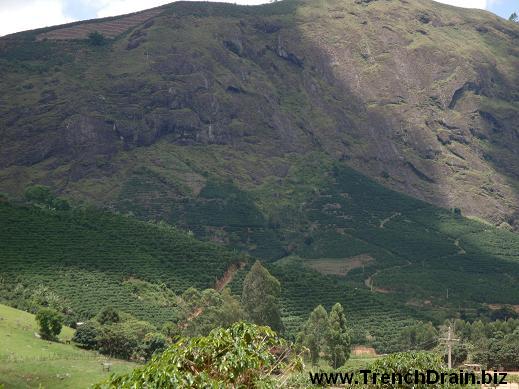 In recent years, I have been traveling to Brazil with my wife over the Thanksgiving holidays to visit family and friends. It is a good time to visit Brazil since it is prior to the busy Christmas season and just the beginning of their summer season. School is still in session, so you basically have the beaches to yourself if you can find a day that the sun is out.
In recent years, I have been traveling to Brazil with my wife over the Thanksgiving holidays to visit family and friends. It is a good time to visit Brazil since it is prior to the busy Christmas season and just the beginning of their summer season. School is still in session, so you basically have the beaches to yourself if you can find a day that the sun is out.
Lately we have been traveling to the Brazilian state of Espirito Santo where we have access to an uncle’s beach house. The drive is eight hours of mountainous terrain that takes you through the heart of their coffee growing region. Along the way, we occasionally stop at roadside luncheonettes for coffee and a piece of cheese bread. In 2008, we made a stop at one such location that just happened to be installing a trench drain. This drain ran along their sidewalk and out into the parking lot where it met with the gasoline pumps. At this time, I took photographs of the construction and filed them away, not really thinking I would be seeing them again.
Almost exactly one year later, I found myself at the same luncheonette to refuel our vehicle and have coffee. I realized when my wife and I arrived that we had been to this location before. This time, the trench construction was completed. I took more photographs to give my readers a before and after view of a trench drain installation that is very different than our approach in the United States.
In Brazil, they have a very different set of circumstances governing their construction industry. First of all, their high unemployment gives rise to low labor costs. Because of low labor costs, there is a tendency to use “man power” rather than “machine power”. For instance, in projects where I would use a backhoe to excavate a small section of ground, they would have a tendency to dig with hand tools.
 Also, as labor is cheap, there is less of a reliance of pre-manufactured or pre-formed construction materials. Sidewalks and parking lots are often made with tile or paving stone rather than concrete. If concrete is used in small quantities, the cement, sand and gravel is brought to the site and the concrete is batched and mixed by hand. Only on large construction projects is a ready-mixed concrete product brought to the site.
Also, as labor is cheap, there is less of a reliance of pre-manufactured or pre-formed construction materials. Sidewalks and parking lots are often made with tile or paving stone rather than concrete. If concrete is used in small quantities, the cement, sand and gravel is brought to the site and the concrete is batched and mixed by hand. Only on large construction projects is a ready-mixed concrete product brought to the site.
In the case of a trench drain installation, this has big implications. There is no pre-cast concrete trench drain that is made off-site and dropped into place. There is no polymer concrete pre-sloped channel with locking cast iron grates to set in place with concrete. These products don’t even exist. Ready-mix concrete is cost prohibitive or difficult to justify on these projects. And, trench drain bar grating is often made by a metal fabrication company or made on site by a craftsman using local materials, such as rebar. However, cast iron and aluminum castings are available in specialty stores.
In this particular installation, the trench was to be used for drainage and for running a utility line. Paving stones were removed from the sidewalk and areas in the parking lot. The ground was hand dug to a 2 foot depth. Luckily in this part of Brazil the weathering of the soil is deep; the earth is predominantly sandy clay which can be hand dug easily when dry.
 Three courses of 100mm wide x 200mm tall concrete block were laid for the walls of the trench. A frame for the grate was mortared to the top of the block. Portions of the block wall were cut away to accommodate placement of the frame anchors. The anchors were then mortared into place.
Three courses of 100mm wide x 200mm tall concrete block were laid for the walls of the trench. A frame for the grate was mortared to the top of the block. Portions of the block wall were cut away to accommodate placement of the frame anchors. The anchors were then mortared into place.
To ensure a proper spacing between the two frame sections, a template was built which emulated the grate. This template was placed between the frames while it was being installed on top of the block wall. To make certain that the grate wasn’t going to fit too tightly, a metal spacer bar was used with the template to guarantee a little extra room.
Throughout the trench, a metal support that ran between the trench walls and about 10 inches off the trench floor was installed every 3 meters. This support was used to carry the utility pipes that ran from the luncheonette to the gasoline pumps. After the frame installation, the trench walls were layered with ½” of waterproof mortar. The floor of the trench was then lined with a few inches of concrete. Bar grating, made off-site, was put in place. Soil was back-filled behind the trench walls and tamped into place. Paving stone was replaced in the sidewalk areas. Alongside the trench in the parking area, a ½ meter concrete border was installed to give additional support to the trench.
 The process used in Brazil for this trench installation was much more labor intensive than we would use in the United States. We probably would have had a backhoe dig the trench. Gravel would have been poured in the trench and compacted into place. A former system, such as EconoDrain, would have been installed to form the trench shape, and a ready-mix concrete truck would have been brought in to supply the concrete. The Brazilian project probably took 1 – 2 months to perform. In the US, this same project would have been a week, at most.
The process used in Brazil for this trench installation was much more labor intensive than we would use in the United States. We probably would have had a backhoe dig the trench. Gravel would have been poured in the trench and compacted into place. A former system, such as EconoDrain, would have been installed to form the trench shape, and a ready-mix concrete truck would have been brought in to supply the concrete. The Brazilian project probably took 1 – 2 months to perform. In the US, this same project would have been a week, at most.
Send me your comments or questions about this article.


